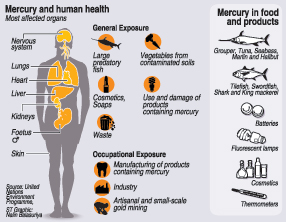News
Mercury watchers issue health warning
View(s):The heavy metal that carries heavy health risks is under close scrutiny, writes Malaka Rodrigo
Mercury is also found in household equipment and instruments, including thermometers and energy saving CFL bulbs. After use, these materials should be disposed of in a responsible way so that their mercury content does not leak into the environment.”
Watch out for the mercury content in beauty products and other common household goods and appliances.
Mercury and its compounds can cause serious health problems, including brain and neurological damage, as well as damage to the kidneys and the digestive system. Victims can also suffer memory loss and language impairment, as well as other health problems.

The Centre for Environmental Justice (CEJ) sent out this warning based on findings among countries that advocate international and local screening of beauty and other products for the presence of mercury.
Mercury is a common substance used in whitening cream, but there is no proper safety screening for mercury content in Sri Lanka, says CEJ’s executive director Hemantha Withanage, as well as Cosmetic Devices and Drugs Regulatory Authority (CDDRA) director Dr. Hemantha Beneragama.
All cosmetic products sold in Sri Lanka should be approved by the CDDRA. For now, products are tested only for arsenic and lead content in the heavy metal category, Dr. Beneragama told the Sunday Times. So far no South-Asian country conducts mercury tests, and the Sri Lanka Standards Institute has no defined level for mercury in cosmetics, he said.
The CDDRA has had discussions with the Industrial Technology Institute (ITI) on mercury testing mechanisms, Dr. Beneragama said. Until standards are determined, cosmetics samples will be sent to Singapore for testing. Consumers should avoid cheap unregistered products that would not have been tested for mercury, Dr. Beneragama said
Mercury is also found in household equipment and instruments, including thermometers and energy saving CFL bulbs. After use, these materials should be disposed of in a responsible way so that their mercury content does not leak into the environment. The Central Environment Authority’s hazardous management programme advises consumers to hand over used CFL bulbs to an E-waste recycler.
The Ministry of Health has recommended phasing out mercury-based thermometers and blood pressure monitoring sphygmomanometers. These instruments are already being phased out at hospitals.
Mercury in the environment can enter the human body through food and food chains, such as fish containing methyl mercury.
A mercury content test was recently conducted in Negombo. Hair and fish samples taken from a Negombo site were sent overseas for testing. The hair samples had between 0.77 and 4.55 parts of mercury per million parts. The Japanese guideline for mercury in seafood is 0.4 parts per million. The local fish samples did not contain a measurable level of mercury. The CEJ pointed out that the research team had collected only one fish species.
The tests were supervised by the Centre for Environmental Justice and an international body called IPEN, which works for a toxic-free future.
Follow @timesonlinelk
comments powered by Disqus















